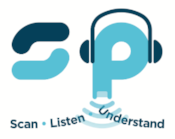Can Moving Dots Tell Us More About Dyslexia in Children?
Spelling and reading are vital skills when it comes to our relationships with work and education – and understanding the ways that they work is an important piece of the puzzle in making sure that we support people with dyslexia and literacy differences. They involve to a large extent mapping what we see on the page, and then processing what we’ve mapped to correspond to a series of sounds and meanings. There’s a large school of thought in dyslexia research at the moment that thinks reading difficulties could at least in part be due to differences in how the dyslexic brain processes visual information, and a new UK study has been exploring this in greater depth.
One visual skill that has been observed to differ between people with dyslexia and people who don’t have dyslexia is the ability to perceive motion – basically, how we compute moving objects and the direction they’re moving in. People with dyslexia tend to need more dots moving in the same direction to accurately judge the overall direction – but until now, we haven’t really understood why this might be, or what the wider implications of it are. But a collaborative study between the University of Reading and Oxford University in England has been digging deeper into the idea of these digital dots and what they offer us in terms of understanding the dyslexic brain a little better.
There’s a much more in-depth run-down of the findings of the study available at The Conversation, but the main takeaway from the study supports the idea that rather than perceiving these moving dots differently, what actually sets apart the two study groups is how they make decisions about it. People with dyslexia appeared to see the moving dots just as easily, but took longer to decide in which direction they’re moving.
What does this mean for how we read?
Although words don’t tend to move on the page as we’re reading them (in print media, at least), differences in how we process these motion tasks could possibly influence children’s ability to read. That’s because the sounds that make up our comprehension of language change quickly over time; just as a moving digital dot can – so rely on the brain processes that can detect these fast changes as well. The ability to process these fast-changing sounds that are the foundations of a language are involved in what we call phonological processing; using the sounds- the ‘phonemes’- of one’s language to process the spoken and the written word. And differences in this mental mechanism have been extensively linked to dyslexia and literacy differences.
If children with dyslexia appear to need more time to make decisions about the direction a digital dot is moving in, they also might find it more difficult and require more time to differentiate between sounds in the spoken and written word. And this could be one of the mechanisms that makes reading more arduous for somebody with dyslexia, as the act of reading and interpreting these phonemes is so dependent on the relationships it sparks with spoken language and meaning.
Where is this research going?
The researchers at the heart of the study- Oxford University’s Gaia Scerif and the University of Reading’s Catherine Manning- are also planning to expand their research base, and explore more about what these digital dots can tell us. They’re set to look into whether children with dyslexia need more time to make decisions for other types of information which we collect via our senses, or whether the difference is only relevant to visual motion.
A further area of interest for the research is expanding on what we know about other skills, and whether things such as general processing speed and cognitive ability are related in any way to the decision-making and reading differences we can observe in people with dyslexia.
Studies that explore the fundamental processing mechanisms of people with dyslexia help researchers to build a better working picture of how the brain works and develops. They also explore how there may be differences between the way neurotypical and neurodiverse brains approach the same tasks. The findings of this study seem to indicate that dyslexia could possibly affect more than a child’s reading and spelling mechanisms – it could be having an impact on their processing mechanisms too, and this is important knowledge when it comes to discussing how best to support young dyslexic minds. Support should be a holistic process that underpins every element of the process of learning, rather than just propping up certain elements of the learning journey.
It’ll be interesting to see where this research goes, and if more information becomes available on the idea of processing, and how best we can support these findings. We’re lucky to live in an age where the technology exists so that we can make sure that children with literacy differences can approach texts with confidence with the technological support that the twenty-first century has on offer. Reading is the gateway to education, but also the world of work – and it’s important that the support we offer is based on how best to support these processes in real-world activities in a way that prioritises convenience, applicability, and ease of use.
